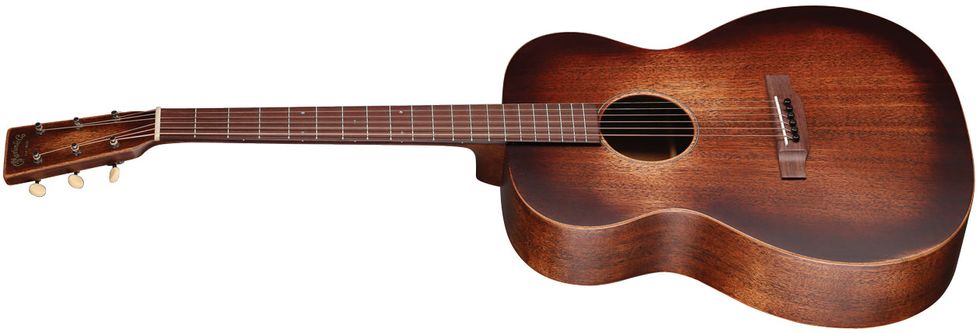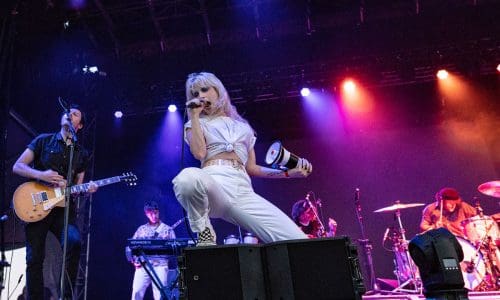Watch Paul Riario Demo Two New SE Acoustics from PRS Guitars
In this clip, Guitar World Tech Editor Paul Riario checks out the Angelis AX20E and Tonare T40E, two stunning new models from PRS Guitars' SE Acoustics series. You can watch the demo above.
The PRS SE AX20E pairs mahogany back and sides with a solid spruce top for warm, balanced tone. When matched with traditional X bracing, which allows the top to vibrate while providing stability, the SE AX20E has a punch that stands alone beautifully or cuts through the mix. The Angelus Cutaway body shape delivers comfort and playability, well suited for picking and fingerstyle playing.
The PRS SE T40E pairs ovangkol back and sides with a solid spruce top for full, lush tone. Along with PRS' hybrid X/Classical bracing, which allows the top to freely vibrate, the SE T40E’s voice projects with breathtaking volume and delicate nuance. The Tonare Grand body shape delivers a familiar feel and a thunderous tone, well suited for picking and fingerstyle playing.
Both SE models feature the Fishman GT1 pickup system, delivering dynamic, organic tone and allowing players to easily take these guitars from rehearsal to stage. This electronics system includes an undersaddle pickup and soundhole mounted preamp with easy-to-access volume and tone controls.
Additional high-quality features on both models include a solid spruce top, ebony fretboard and bridge, bone nut and saddle, as well as PRS trademark bird inlays and headstock design. All PRS SE acoustics ship with a high-quality hardshell case.
To find out more, head over to prsguitars.com.
Acoustic Soundboard: Aged Acoustics Come of Age
 Martin’s all-mahogany Streetmaster models have a broken-in vibe without the scarring of dents and scratches.
Martin’s all-mahogany Streetmaster models have a broken-in vibe without the scarring of dents and scratches.
New electric guitars with distressed finishes have been around for decades. In fact, aged reproductions of the iconic 1959 sunburst Les Paul Standard were being crafted before the original examples were even 20 years old. But new acoustic guitars with pick scratches, belt-buckle dents, and artificially produced lacquer checking? Acoustic purists scoffed, “No way!” Now, of course, new acoustic guitars with distressed finishes are far more common, and not all of them are high-end models. Some guitar fans might be asking what happened, but others are wondering why it took so long for the acoustic side of the guitar market to catch such an obvious wave.
We don’t know if it was the scoffing about artificially aged acoustics or a perceived lack of demand, but there was little change until the late 1990s, when some cracks began to appear in the “no phony wear” armor. Inspired by distressed-finish guru Tom Murphy, whose efforts on Les Pauls could be eerily realistic, Gibson began producing a few acoustic flattop reissues with crazing lines in the lacquer, artificially created by carefully scribing them with an X-Acto blade.
While the new century was still a toddler, distressed-finish solidbody electrics had become a firmly established part of the guitar market, with Telecasters and Stratocasters being the most common—partly because Fenders are so easy to disassemble. One company, Nash Guitars, was growing rapidly and only produced aged-finish Fender-style instruments. In all fairness, Bill Nash didn’t limit his modifications to dinged body edges and finger-stained maple fretboards. Both the pickups and the playability were tweaked to be significantly different than what you would find on a new Fender-branded Strat or Tele.
Several things came together in the last decade that seemed to push acoustics closer to the new-but-looks-old zone that was continuing to soak up an increasing percentage of electric guitar sales. There was the return to using animal-protein glue for the assembly of reissue models, and carefully documented searches for “vintage spec” parts were highly publicized, sending online forums into a frenzy. The biggest boost was torrefaction, the process of thermo-curing tonewoods so they have more of the characteristics of wood that hasn’t recently been part of a live tree. Last but not least was the return to thinner, all-nitrocellulose lacquer finishes. This led to a widespread acceptance of new guitars without the deep, glossy, reflective shine that had been the industry standard for as long as anyone could remember. But at this point, manufacturers of acoustics were still striving to achieve the look of a brand-new guitar, but one that had just left the factory 80 years ago.
As new reissues have become more and more exactly like the originals, there is less reason to pay the huge premium to get an old version.
That “like brand new but old” fixation changed abruptly when two guys in North Carolina, Wes Lambe and Ben Maschal, teamed up as Pre-War Guitars and changed the game plan for vintage-style acoustics. Like Nash Guitars, Pre-War isn’t the custom shop wing of a heritage brand, which means they can offer reissues of a late 1930s Gibson Advanced Jumbo or a Martin D-28 side by side. To avoid copyright issues, Pre-War has done some clever renaming. For example, the “AJ” model refers to their “American Jumbo.” Most importantly—along with torrefied wood, thin lacquer, and original-style parts and details—Pre-War added simulated playing wear—sometimes a lot of it.
Of course, we can’t claim that Fender’s Road Worn models are the company’s reaction to Bill Nash’s success, and maybe C.F. Martin’s recently released Aged D-18 and D-28 Authentic models were not prompted by the Pre-War Guitars versions of those same Martin dreadnoughts. We’re guessing there’s a connection, and, thankfully, for acoustic players who don’t want to shell out big bucks for a new guitar that doesn’t look new, Martin offers Streetmaster all-mahogany models that have only light distressing. The aging on these guitars is only to the finish and the result is a nice patina, and a selling price under $1,500. (Fender’s Road Worn models sell for under $1,000.) Once big companies like Fender and Martin bring their pricing power to bear, consumers often get more options for less money. Remember when you could only get vintage-style tuners on custom-shop models?
With C.F. Martin offering aged versions of its classic models, it seems unlikely that new acoustics with distressed finishes are a fad that will soon disappear. What does this tell us? One thing is that as new reissues have become more and more exactly like the originals, there is less reason to pay the huge premium to get an old version. And if you like the look and feel of older guitars, a perfect new reissue is kind of a contradiction, if only because many players don’t want a new-looking guitar from decades ago. They want a guitar that has survived all those decades and shows it.
Purists who scoff at distressed finishes on new instruments can look to the violin trade for consolation. New violins that looked like an old, heavily played Stradivarius were widely available over 200 years ago.
L-Acoustics K1/K2 Arrays Power A Tribute to Chris Cornell
L-Acoustics’ K1 & K2 arrays were front-and-center during the five-hour fundraising event, “I Am the Highway: A Tribute to Chris Cornell.”
The event featured sets from Cornell’s bands — Soundgarden, Temple of the Dog, and Audioslave — and appearances from The Melvins, Miley Cyrus, Brandi Carlile, Fiona Apple, Josh Homme and Ziggy Marley.
Long-time collaborators Rat Sound, a sales and rental company, and Soundgarden teamed up once again for the benefit show.
The relationship between Rat Sound and Soundgarden dates back to 1990 where, during a tour with Danzig, Rat Sound chose a mix of L-Acoustics, DiGiCo and Avid products.
A Tribute to Chris Cornell: Sound Requirements
To address the sound requirements of the tribute show, Rat Sound specified 12 L-Acoustics K1 arrays over six K2s for the main hangs and eight K1s over four K2s for the stage’s side hangs.
Rat Sound also employed 13 additional K2s per side to deliver 270-degrees of coverage to the sold-out 18,000-seat Los Angeles Forum arena.
Augmenting the tonal capabilities of the K1/K2 arrays were 20 KS28 subwoofers setup on the floor, as well as eight ARCS II and eight Kara II cabinets used for front fills.
Different Acoustical Areas Addressed with L-Acoustics K1 & K2
Tom Worley, account manager, Rat Sound, says an area was set up for acoustic ensembles and soloists to perform, while backlines changed out between sets.
“We had some L-Acoustics X15 HiQ wedges across the front of that thrust that handled all of the acoustic acts,” he notes.

Other parts of the system design included ARCS II and KS28 subwoofers used for sidefills for the main stage.
Greg Nelson, front of house (FOH) engineer for Pearl Jam and the the FOH for Temple of the Dog’s 2016 reunion tour, used a DiGiCo SD5 console for the full-length sets from Soundgarden and Temple of the Dog, along with a second SD5 that handled both bands’ monitors.
“We took a MADI split of the SD-Rack into an [DiGiCo] SD9 for guest artists,” says Worley.
“All the guest vocalists and anyone that came up as a guest guitarist or instrumentalist had a set of in-ears and a set of wedges running off the SD9.”
Mixing Capabilities
Moreover, DiGiCo SD12s were used at FOH and at the stage to mix acoustic sets. Production, such as host mic and video segments between performances, was also driven by DiGiCo.
An Outline Newton audio processor was used for signal routing and more than 100 wireless channels were employed for microphones, backlines and IEMs (in-ear monitors). 

During the course of the show, Worley admits that some devices shared channels, but says there were no performance issues.
In addition, Rat Sound archived the show’s entire 42 songs with Avid VENUE S6L desks that were used for multitrack recording.
“Just for the usability with Pro Tools, we had four Avid Stage 64 I/O racks, which we land beside each monitor position, and came out of everyone’s splits analog,” adds Worley.
“We picked up the stage racks as we needed them and had a main and redundant AVB stream off each desk in a production room backstage.”
Proceeds from the Tribute to Chris Cornell benefit show went to the Chris and Vicky Cornell Foundation, and the Epidemolysis Bullosa Medical Research Foundation.
No comments:
Post a Comment